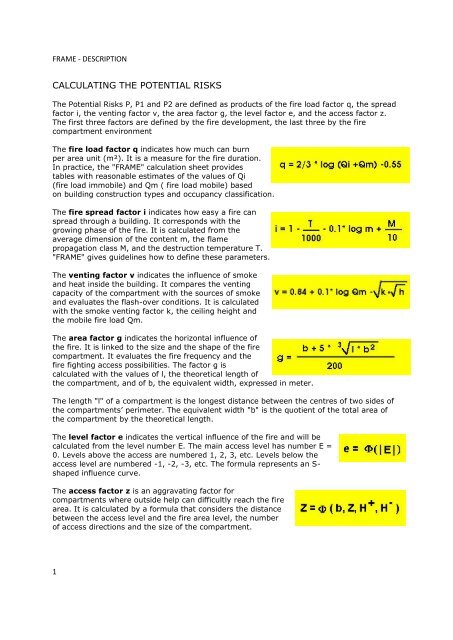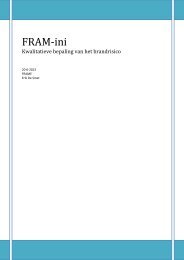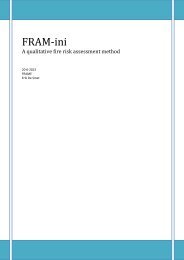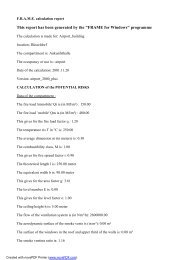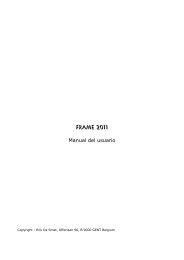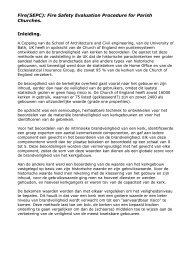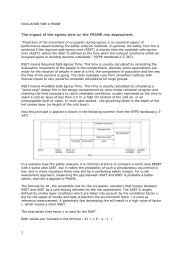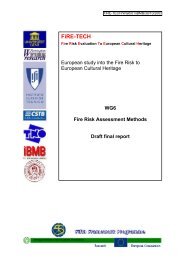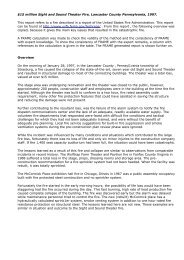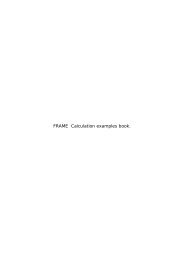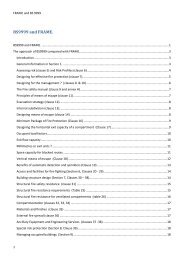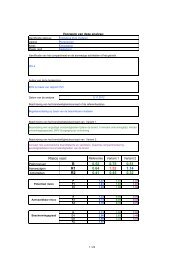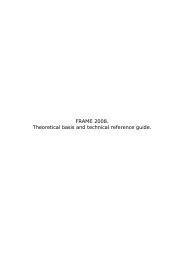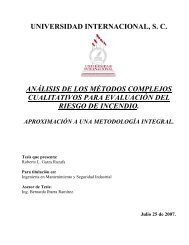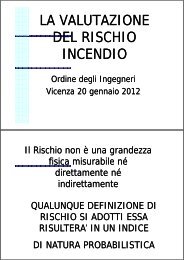PRINT THIS PAGE (pdf) - FRAME Fire Risk Assessment Method for ...
PRINT THIS PAGE (pdf) - FRAME Fire Risk Assessment Method for ...
PRINT THIS PAGE (pdf) - FRAME Fire Risk Assessment Method for ...
You also want an ePaper? Increase the reach of your titles
YUMPU automatically turns print PDFs into web optimized ePapers that Google loves.
<strong>FRAME</strong> - DESCRIPTION<br />
CALCULATING THE POTENTIAL RISKS<br />
The Potential <strong>Risk</strong>s P, P1 and P2 are defined as products of the fire load factor q, the spread<br />
factor i, the venting factor v, the area factor g, the level factor e, and the access factor z.<br />
The first three factors are defined by the fire development, the last three by the fire<br />
compartment environment<br />
The fire load factor q indicates how much can burn<br />
per area unit (m²). It is a measure <strong>for</strong> the fire duration.<br />
In practice, the "<strong>FRAME</strong>" calculation sheet provides<br />
tables with reasonable estimates of the values of Qi<br />
(fire load immobile) and Qm ( fire load mobile) based<br />
on building construction types and occupancy classification.<br />
The fire spread factor i indicates how easy a fire can<br />
spread through a building. It corresponds with the<br />
growing phase of the fire. It is calculated from the<br />
average dimension of the content m, the flame<br />
propagation class M, and the destruction temperature T.<br />
"<strong>FRAME</strong>" gives guidelines how to define these parameters.<br />
The venting factor v indicates the influence of smoke<br />
and heat inside the building. It compares the venting<br />
capacity of the compartment with the sources of smoke<br />
and evaluates the flash-over conditions. It is calculated<br />
with the smoke venting factor k, the ceiling height and<br />
the mobile fire load Qm.<br />
The area factor g indicates the horizontal influence of<br />
the fire. It is linked to the size and the shape of the fire<br />
compartment. It evaluates the fire frequency and the<br />
fire fighting access possibilities. The factor g is<br />
calculated with the values of l, the theoretical length of<br />
the compartment, and of b, the equivalent width, expressed in meter.<br />
The length "l" of a compartment is the longest distance between the centres of two sides of<br />
the compartments’ perimeter. The equivalent width "b" is the quotient of the total area of<br />
the compartment by the theoretical length.<br />
The level factor e indicates the vertical influence of the fire and will be<br />
calculated from the level number E. The main access level has number E =<br />
0. Levels above the access are numbered 1, 2, 3, etc. Levels below the<br />
access level are numbered -1, -2, -3, etc. The <strong>for</strong>mula represents an S-<br />
shaped influence curve.<br />
The access factor z is an aggravating factor <strong>for</strong><br />
compartments where outside help can difficultly reach the fire<br />
area. It is calculated by a <strong>for</strong>mula that considers the distance<br />
between the access level and the fire area level, the number<br />
of access directions and the size of the compartment.<br />
1
<strong>FRAME</strong> - DESCRIPTION<br />
CALCULATING THE ACCEPTANCE LEVELS<br />
The acceptance level reflects the fact that people can live with the threat of fire up to a<br />
certain level, i.e. when the exposure to fire is limited. The exposure is linked to the presence<br />
of ignition sources, to egress conditions <strong>for</strong> people and to economical data <strong>for</strong> property and<br />
business.<br />
A higher exposure results in a lower acceptance level. The Acceptance Levels are calculated<br />
with the activation factor a, the evacuation time factor t, the environment factor r and the<br />
dependency factor d. The activation factor a represents the presence of ignition sources, the<br />
environment factor r and the evacuation time factor t evaluate the egress conditions. The<br />
content factor c and the dependency factor d evaluate the economic data.<br />
The activation factor a is defined through a review of possible fire<br />
sources, as a sum of all relevant values, referring to the following types of<br />
fire sources: Main activities, secondary activities, process and room heating<br />
systems, electrical Installations, presence of flammable gases, liquids and<br />
dusts. The "<strong>FRAME</strong>" calculation sheet provides lists and guidelines.<br />
The evacuation time factor t is calculated by a <strong>for</strong>mula including the dimensions of the<br />
compartment, the number of people, exit units and exit paths, and the mobility factor.<br />
"<strong>FRAME</strong>" allows also the use of an evacuation time defined by simulation or by evacuation<br />
drills.<br />
The content factor c will evaluate the possibility to replace the<br />
building and its content, and the monetary value. The calculation<br />
allows <strong>for</strong> various currencies and building cost inflation.<br />
The environment factor r will reflect the running speed of fire, and the dependency factor d<br />
will measure how much a business can be touched by fire.<br />
CALCULATING THE PROTECTION LEVELS<br />
The probability that a beginning fire develops into a catastrophy depends largely on the<br />
available means to fight or to stop the fire growth. Such means are the active and passive<br />
fire protection means that are present. "<strong>FRAME</strong>" calculates the protection levels with 6<br />
groups of provisions, called W, the water supply factor; N, the normal protection factor; S,<br />
the special protection factor; F, the fire resistance factor; U, the escape factor and Y, the<br />
salvage factor.<br />
The water supply factor W considers the type and capacity of the water<br />
storage and the distribution network <strong>for</strong> fire fighting. A number of<br />
minimum criteria are given and failure to meet them results in a lower<br />
value <strong>for</strong> W and a correspondingly higher risk level.<br />
The normal protection factor N considers guard services, manual fire<br />
fighting, time delay of fire brigade intervention, personnel training. A<br />
2
<strong>FRAME</strong> - DESCRIPTION<br />
number of minimum criteria are given and failure to meet them results in a lower value <strong>for</strong> N<br />
and a correspondingly higher risk level.<br />
The special Protection factor S considers automatic detection, improved<br />
water supplies, automatic protection, and fire brigade <strong>for</strong>ce. The<br />
availability of high per<strong>for</strong>mance and highly reliable protection results in<br />
a higher value <strong>for</strong> S and a correspondingly lower risk level <strong>for</strong> property and activities.<br />
The fire resistance factor F considers the fire resistance of the<br />
structural elements, outside walls, ceiling or roof and inner walls. The<br />
<strong>for</strong>mula makes a balance of these elements and the available special<br />
protection. A higher level of fire resistance results in a high value <strong>for</strong> F<br />
and a correspondingly lower level of property risk.<br />
The escape factor U considers every measure that speeds up the<br />
evacuation or slows down the early development of fire. It considers the<br />
effect of special protection in the early stages of fire development and<br />
multiple and protected egress capacity. A higher level of protection<br />
results in a lower level of risk <strong>for</strong> the occupants.<br />
The salvage factor Y considers protection of critical items and<br />
contingency planning. A higher level of protection results in a lower level<br />
of risk <strong>for</strong> the activities.<br />
© Erik De Smet<br />
3


